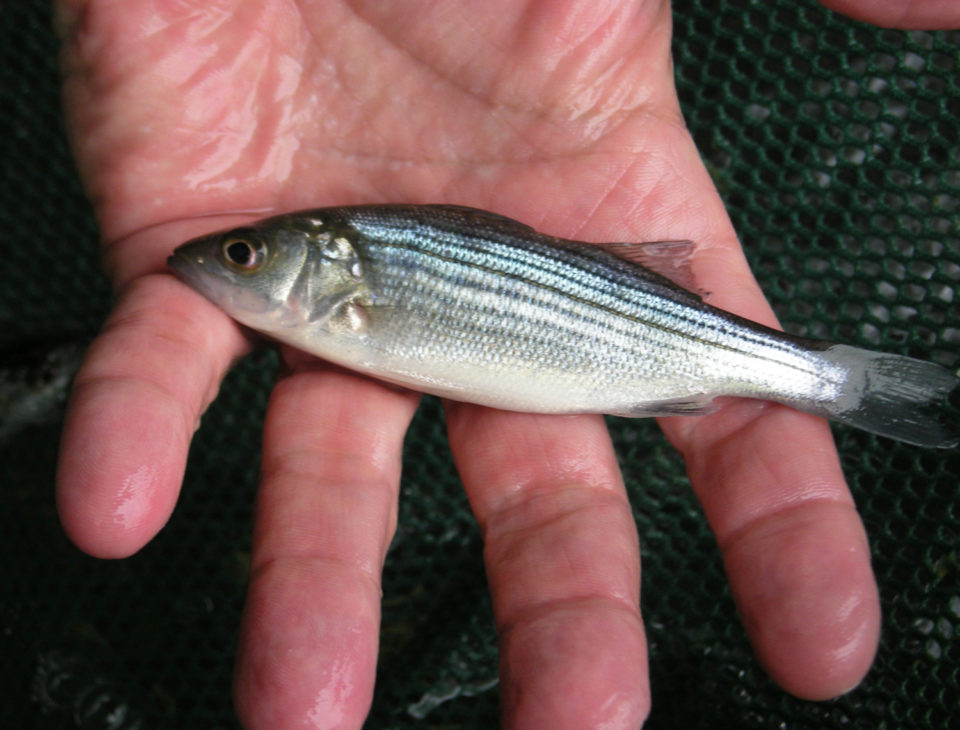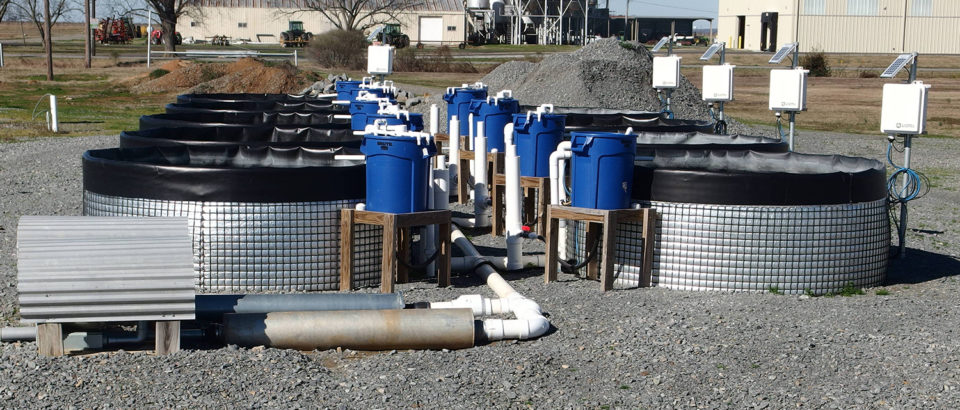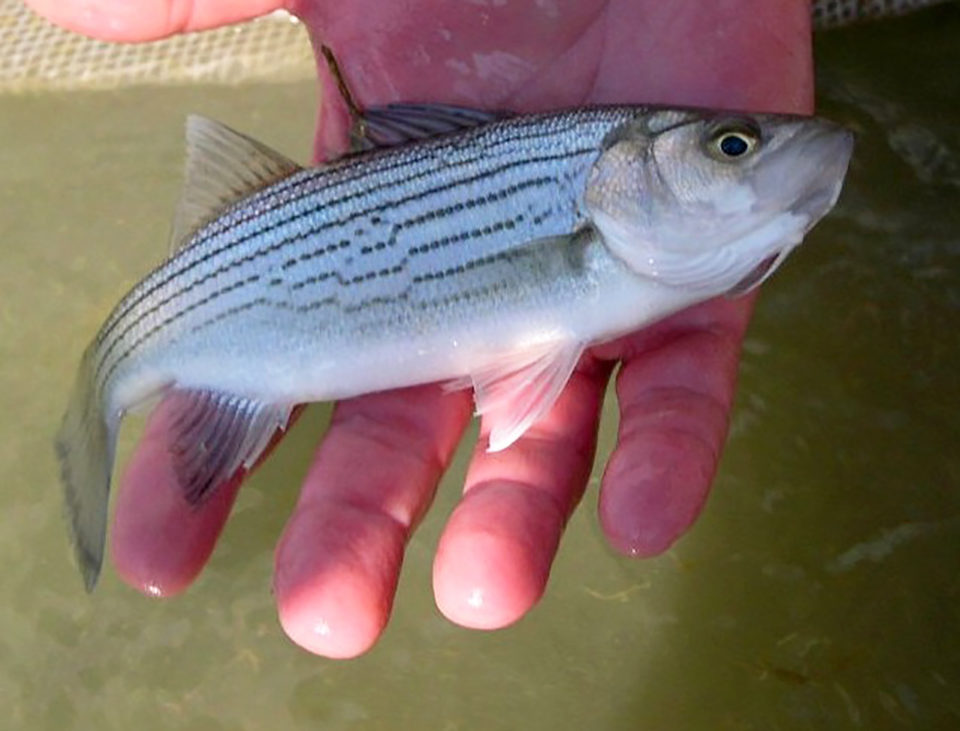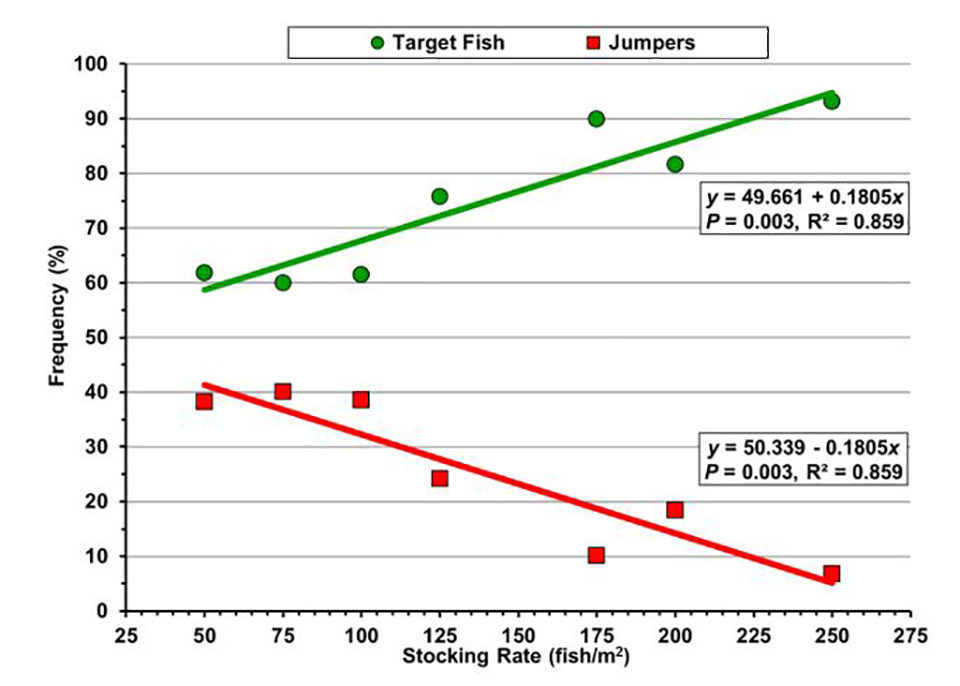Study shows potential to intensify production in an outdoor biofloc production system

Biofloc technology (BFT) production systems are widely used in the culture of shrimp, tilapia and other aquatic species. However, because the biofloc is a water quality management tool, BFT production systems can be used to grow other fish species like channel catfish.
The sunshine bass is a hybrid produced by crossing a female white bass and male striped bass (Morone chrysops x Morone saxatilis). It is the basis for important recreational fisheries in many areas in the United States, as well as commercial aquaculture. Sunshine bass producers use either a three-phase or two-phase (direct stock) production system to produce market-size fish. Production survival for sunshine bass is higher when advanced fingerlings are stocked for growout compared to smaller fish – research has shown that direct stocking of 5-gram fingerlings in grow-out ponds results in higher production and survival than stocking 3-gram fingerlings.
Therefore, intensification of the sunshine bass hatchery phase (phase I) has received significant attention from researchers, but there is little published information on the intensified production of advanced fingerlings, so the goal of our study was to begin quantifying the stocking rate production function for juvenile sunshine bass (Morone chrysops × M. saxatilis) in an outdoor, mixotrophic BFT production system. This article summarizes the original publication Journal Of The World Aquaculture Society doi: 10.1111/jwas.12491.
Study setup
We conducted this dose-response study outdoors at the U.S. Department of Agriculture ARS Harry K. Dupree Stuttgart National Aquaculture Research Center (HKDSNARC; in Stuttgart, Ark., USA). The experimental setup included nine 2.4-meter diameter (4.7 square meter, 3.6 cubic meter) high-density polyethylene lined, wire-mesh framed, aerated tanks with continuous settling chamber operation (ca. 2 L/minute flow rate).
The experimental tanks were filled with water with an established biofloc, and were fertilized two weeks before stocking fish with a single dose of dried molasses and beet pulp, and treated with NaCl to ensure that chloride concentration exceeded 100 mg/L. No other source of organic carbon other than fish diet was added to tanks. Sodium bicarbonate was added as needed to maintain total alkalinity and pH. Water was added to tanks to replace losses due to evaporation and periodic draining of settling chambers.

Sunshine bass (1.2 ± 0.4 g/fish) from a local fish farm were quarantined, fed for two weeks, and stocked at randomly assigned stocking rates into tanks at 50, 75, 100, 125, 150, 175, 200, 225, and 250 fish per square meter. Mean (± SD) initial weight was 2.9 ± 0.2 g/fish (coefficient of variation, CV=6.9 percent).
The experimental protocol was approved (Approval Number 2015-003) by the HKDSNARC Institutional Animal Care and Use Committee and conformed to ARS Policies and Procedures 130.4 and 635.1. During the study, one fish die-off occurred overnight in the 225-fish per square meter tank and most of the fish died for unknown reasons, as the water quality parameters were within acceptable ranges. Therefore, data from this tank were excluded from analyses and reporting.
Fish were fed twice daily a commercially formulated 1.5-millimeter floating extruded diet (45 percent protein, 12 percent lipid) prior to stocking and in days 1 through 10 of the experiment.
From day 10 through day 18, this diet was fed 1:1 with a 40 percent protein, 10 percdent lipid, 3.2-mm floating extruded diet – thereafter, the latter diet was fed for the rest of the study. During the first week the feeding rate was 8 percent of the biomass at stocking, and thereafter the fish were fed as much as they would consume in 10 min.
Water samples were collected from each tank early morning beginning 6 days before stocking fish and continuing at weekly intervals through the end of the experiment, and analyzed for several water quality variables.
Fish were harvested from tanks 94 days after stocking, and because their size distribution appeared bimodal, animals were separated into two size groups: smaller than 115 mm total length (TL) and larger than 115 mm TL, and were denominated “target fish” and “jumpers,” respectively.
Individual weights and total lengths were measured and recorded for 100 small and 100 large fish (or all large fish for n<100) from each tank. All remaining fish in each size group were counted and weighed in bulk. Feed efficiency (net weight of fish harvested divided by the total quantity of feed fed on a dry matter basis) was calculated, and random samples of 10 fish each were collected for the determination of body compositional indices and whole-body composition, respectively, and body compositional indices (Hepatosomatic index, HSI; and Viscerosomatic index, VSI) were measured.
For more detailed procedures on the experimental setup – including experimental design, sample collection and analysis; whole-body analysis and statistical analyses – refer to the original publication.
Results and discussion
This is the first report of growing sunshine bass in a near-zero-water-exchange BFT production system, although sunshine bass have been grown successfully at high stocking and feeding rates in vertical raceways and recirculating aquaculture systems (RAS). The fish in our outdoor BFT study survived and grew adequately and independently of stocking rate, with overall water quality variables within adequate ranges. Results show gross and net fish yields of 1.4 to 3.1 kg per cubic meter and 1.2 to 2.7 kg/m3, respectively, and with gross fish yield independent of mean TSS concentration (Table 1).
Green, Biofloc, Table 1
| Stocking rate | GFY | NFY | Survival | Feed daily | Feed total | Feed efficiency | PRE | ERE | Lipid RE |
|---|
Stocking rate | GFY | NFY | Survival | Feed daily | Feed total | Feed efficiency | PRE | ERE | Lipid RE |
|---|---|---|---|---|---|---|---|---|---|
| 50 | 1.4 | 1.2 | 85.4 | 38.4 | 4.9 | 0.30 | 9.7 | 10.7 | 41.3 |
| 75 | 2.5 | 2.2 | 86.3 | 52.0 | 6.7 | 0.39 | 13.0 | 13.7 | 52.5 |
| 100 | 3.1 | 2.7 | 86.7 | 58.2 | 7.6 | 0.42 | 14.2 | 15.3 | 59.6 |
| 125 | 2.7 | 2.2 | 82.0 | 58.6 | 7.5 | 0.38 | 11.4 | 12.9 | 49.5 |
| 150 | 2.1 | 1.6 | 39.4 | 74.3 | 9.5 | 0.24 | 6.6 | 7.5 | 31.2 |
| 175 | 2.4 | 1.8 | 74.9 | 67.2 | 8.7 | 0.29 | 7.9 | 8.5 | 32.3 |
| 200 | 3.1 | 2.4 | 74.0 | 71.4 | 9.1 | 0.36 | 10.1 | 11.4 | 43.5 |
| 250 | 3.1 | 2.2 | 82.7 | 72.3 | 9.3 | 0.35 | 9.5 | 10.5 | 43.7 |
| Regression | NS | NS | NS | Linear | Linear | NS | NS | NS | NS |
| P>F | 0.112 | 0.464 | 0.131 | 0.005 | 0.006 | 0.739 | 0.275 | 0.301 | 0.382 |
| R2 | 0.425 | 0.112 | 0.394 | 0.757 | 0.745 | 0.020 | 0.194 | 0.176 | 0.129 |
Target fish had mean final weights of 9.8 to 16.5 g/fish and decreased linearly with stocking rate; for jumpers the average weights were 40.3 to 55.5 g/fish and independent of stocking rate. The final weight CV for target fish increased linearly with stocking rate but for jumpers it was independent of stocking rate, and the final weight CV were 28 to 46 percent and 29 to 60 percent for target and jumpers, respectively. The mean final total length decreased significantly as stocking rates increased, and the final length CV increased linearly with stocking rate for target fish and trended negative for jumpers.
Results showed that fish survival was independent of stocking rate with an overall average of 81.7 percent, not including the 225-fish/m2 tank that experienced some mortalities. Survival was also independent of TSS concentration but decreased linearly when this tank was excluded.
Although our resulting, overall fish survival was satisfactory and within limits reported for growing sunshine bass fingerlings in ponds and other systems, we do not know the mechanism through which TSS concentration appeared to negatively affect fish survival. In other studies, increased survival of larval sunshine bass in tanks was associated with elevated turbidity levels, possibly due to decreased cannibalistic interactions between the fish. So, reducing solids may positively affect survival and growth of juvenile sunshine bass. More studies are needed to elucidate the relationship between TSS concentration, and survival and growth of juvenile sunshine bass in outdoor BFT systems.

In general, when feed is not limiting fish yield increases with stocking rate until the biomass at stocking equals the carrying capacity. However, our result of an absence of a positive stocking rate-fish yield relationship was the opposite of results reported by other studies for various life stages of sunshine bass for various culture environments. Our study also showed that daily feed rates and total feed additions increased linearly with stocking rate, and that feed efficiency and protein, energy, and lipid REs were independent of stocking rate.
Whole-body composition results were consistent with results reported for sunshine bass by others. The retention efficiencies (RE), however, were poor because of the poor feed efficiencies that resulted from overfeeding the fish. Feed efficiency reported for sunshine bass ranges from 0.37 to 0.94. Although fish were fed daily to apparent satiation, several factors likely contributed to the overfeeding, including a well-developed biofloc and limited visibility in the water column due to high TSS concentrations.
Results showed that body composition indices were independent of stocking rate, that at harvest there were two distinct fish size groups (possibly a feeding hierarchy with larger fish limiting feeding behavior of smaller ones), and that size distributions of target and jumper fish shifted significantly toward smaller sizes with increasing stocking rate. In response to increased stocking rate, target fish increased linearly from 62 to 93 percent and jumpers decreased linearly from 38 percent to 7 percent of the population, respectively (Fig. 1). Stocking rate also impacted the population structure at harvest, and a plausible explanation is competition for food or some breakdown of normal behavior.

Further research can determine if additional increases in stocking rate can reduce the proportion of jumper fish. This possible result would positively affect production practices for sunshine bass by increasing productivity and also by reducing the need to grade fish before stocking for rearing to food fish size.
Perspectives
Results of our study showed the potential of the outdoor BFT production system for intensifying the production of advanced sunshine bass fingerlings. Growing larval fish indoors through the live-feed stage, followed by transfer to an outdoor BFT production system as they transition to formulated diets could improve production efficiency of advanced fingerlings. However, further research is needed to optimize stocking rates and solids management, after which an economic analysis must be performed.
References available from first author.
Authors
-
Bartholomew W. Green, Ph.D.
United States Department of Agriculture (USDA)
Agricultural Research Service (ARS)
Harry K. Dupree Stuttgart National Aquaculture Research Center
P.O. Box 1050
Stuttgart, Arkansas
72160-1050 USA -
Steven D. Rawles
United States Department of Agriculture (USDA)
Agricultural Research Service (ARS)
Harry K. Dupree Stuttgart National Aquaculture Research Center
P.O. Box 1050
Stuttgart, Arkansas
72160-1050 USA -
Carl D. Webster, Ph.D.
United States Department of Agriculture (USDA)
Agricultural Research Service (ARS)
Harry K. Dupree Stuttgart National Aquaculture Research Center
P.O. Box 1050
Stuttgart, Arkansas
72160-1050 USA -
Matthew E. McEntire
United States Department of Agriculture (USDA)
Agricultural Research Service (ARS)
Harry K. Dupree Stuttgart National Aquaculture Research Center
P.O. Box 1050
Stuttgart, Arkansas
72160-1050 USA
Tagged With
Related Posts

Health & Welfare
Egg saprolegniasis in a commercial sunshine bass hatchery
Fungal growth on the eggs caused by the water mold Saprolegnia spp. is an obstacle to the larval production of sunshine bass. This study confirmed that copper sulfate can be an economical and valuable resource in hatchery management for the control of saprolegniasis on sunshine bass eggs in McDonald jars.

Aquafeeds
Biofloc systems viable for tilapia production
Well-designed and managed biofloc technology systems are a viable alternative for production of various species like tilapia, to increase feed efficiency by lowering aquafeed protein requirements and to help reduce or eliminate effluent discharges.

Intelligence
Biofloc technology production promising in temperate zones
A study was conducted to assess the feasibility to grow Channel catfish (Ictalurus punctatus) in an outdoor biofloc system during winter in a temperate zone. High biomasses of market-size channel catfish were successfully maintained through the winter with high survival and in good condition in both treatments.

Intelligence
Are omega-3s in farmed jade perch as high as believed?
Farmed jade perch – similar to other cultured fish species – is only rich in omega-3 fatty acids if its diet consists of these nutrients in high amounts. How does it compare to the wild fish?


